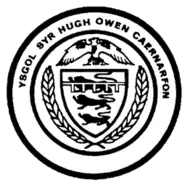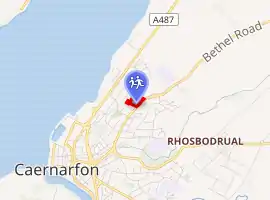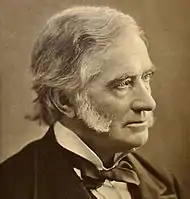Ysgol Syr Hugh Owen
Ysgol Syr Hugh Owen, (English: Sir Hugh Owen School) is a bilingual comprehensive secondary school for pupils aged 11–18, situated in Caernarfon, Gwynedd, Wales. The school was established in 1894, the first to be built under the Welsh Intermediate Education Act of 1889, which was heavily influenced by the educator Sir Hugh Owen, after whom the school was named.
| Ysgol Syr Hugh Owen | ||||||||||||
|---|---|---|---|---|---|---|---|---|---|---|---|---|
 | ||||||||||||
| Address | ||||||||||||

| ||||||||||||
Bethel Road , , LL55 1HW Wales | ||||||||||||
| Coordinates | 53.1462°N 4.2633°W | |||||||||||
| Information | ||||||||||||
| Type | Comprehensive | |||||||||||
| Motto | Hau Hadau'r Dyfodol (Sowing the seeds of the future) | |||||||||||
| Established | 1894 | |||||||||||
| Local authority | Gwynedd | |||||||||||
| Headteacher | Clive Thomas | |||||||||||
| Gender | Coeducational | |||||||||||
| Age | 11 to 18 | |||||||||||
| Enrolment | 836 | |||||||||||
| Language | Welsh / English | |||||||||||
| Houses |
| |||||||||||
| Colour(s) | Navy and Red
| |||||||||||
| Publication | Seren Syr Hugh | |||||||||||
| Website | www | |||||||||||
The school had 836 pupils on roll in 2016.[1] Its current headteacher is Paul Mathews Jones. It serves the town of Caernarfon and the nearby villages, which include; Bontnewydd, Caeathro, Y Felinheli, Llandwrog, Rhosgadfan, Rhostryfan .[2]
Welsh is the school's main language of communication and administration.[3] All subjects, except Welsh and English, are taught to all pupils using both languages.[1] According to the latest Estyn report, 90% of pupils speak Welsh with their families and 92% are fluent in the language.[4] The school claims that 98% of pupils were fluent in Welsh in 2016.[3]
There is also a sixth form, which enables students to stay at the school for a further two years instead of having to transfer to college.
History
Establishment
As an advocate of education reform, Hugh Owen recognised the need for improvements in the schools of Wales. Being both a member of the British and Foreign School Society and the Cambrian Educational Society, Owen enthusiastically supported the idea of non-denominational day schools. During the 1840s he wrote two letters to the people of Wales, acknowledging the need to establish such schools.[5] His efforts were partially successful, as it consequently lead to the creation of a number of schools in the country, but many schools suffered from a lack of qualified teachers. In order to train teachers, Owen saw the need to be a benefactor of more universities, those being Bangor Normal College, Swansea University, and University College of Wales in 1875.[6]

Upon retiring to raise funds for the University College of Wales in Aberystwyth, Owen turned his attention once more to the need of education reform in schools. Owen wanted to qualify students sufficiently to be accepted by the newly established universities. At a lecture at the 1880 National Eisteddfod in Caernarfon, Owen read a paper entitled Intermediate Education in Ireland and Secondary Education in Wales to members of the Cymmrodorion, where he highlighted the need of more intermediate schools. The following year Owen was knighted for his services in education, but died three months after, aged 77.[7]
The paper he read would eventually lead to the passing of the Welsh Intermediate Education Act of 1889. The purpose of the act was detailed in clause two, as follows;
Purpose of Act
- 2. The purpose of this Act is to make further provision for the intermediate and technical education of the inhabitants of Wales and the county of Monmouth.[8]
The first intermediate school was established in Caernarfon, to serve the whole of Caernarfonshire. Royal assent was given in 1893 and the school opened in February 1894. The school was later renamed in Sir Owen's honour, but was at the time known as the Caernarvon County School due to the county-wide provision of the new schools.[9]
Attempt to burn down the school
On 15 August 1913, the County School was a target of a failed attempt to burn the building down. It was suspected that the Suffrage movement was responsible for the attempt, and did the act as a protest.[10]
Notable former pupils
- Guto Bebb - Conservative Party politician and the Member of Parliament for Aberconwy
- Nathan Craig - Footballer who plays for Caernarfon Football Club (ex Everton and Wales U21)
- William David Davies - Presbyterian minister and writer on theological topics
- Wyn Davies - former footballer for Bolton, Newcastle Utd., Manchester Utd., Manchester City & Wales
- Professor William Charles Evans FRS - Biochemist, Bangor University [11]
- Selwyn Iolen, born Selwyn Griffiths - Welsh language poet
- Cai Griffiths - Rugby union player
- William John Gruffydd - writer and politician
- Emily Huws - Welsh language children's author
- Jamie Jones (DJ) - DJ, producer and two time DJ Awards winner
- Hywel Lewis - Welsh theologian and philosopher
- Mari Lövgreen - Television presenter
- Ray Mielczarek - Footballer
- Bryan Orritt - Footballer
- Emrys Roberts - Liberal politician and businessman
- Kate Roberts - Welsh language author
- Winston Roddick - Barrister, and former Police and Crime Commissioner for North Wales Police
- Dafydd Wigley - Plaid Cymru politician and Member of Parliament for Caernarfon (UK Parliament constituency)
References
- "mylocalschool.wales.gov.uk/school.htm?estab=6614039&iaith=eng". mylocalschool.wales.gov.uk. Retrieved 27 September 2016.
- "School Information". Ysgol Syr Hugh Owen. 2011.
- "Ysgol Syr Hugh Owen Prospectus 2016-2017" (PDF). Ysgol Syr Hugh Owen. Ysgol Syr Hugh Owen. Retrieved 16 November 2016.
- "Ysgol Syr Hugh Owen Estyn Report" (PDF). Estyn. Estyn. Retrieved 27 September 2016.
- "Who was Sir Hugh Owen", Aberystwyth University
- "Sir Hugh Owen Memorial Lecture", Bangor University
- "OWEN, Sir HUGH", Welsh Biography Online
- "Welsh Intermediate Education Act 1889", Education in England
- Phil Carradice, "The Welsh Intermediate Education Act, 1889", BBC Wales, Monday 12 August 2013, 16:22
- "Marking century since Suffragettes accused of burning Caernarfon school" Archived March 4, 2014, at the Wayback Machine, Gwynedd Council
- "Llyfrgell Genedlaethol Cymru :: Y Bywgraffiadur Cymreig". wbo.llgc.org.uk. Retrieved 21 October 2018.
External links
- Official website (in Welsh and English)
